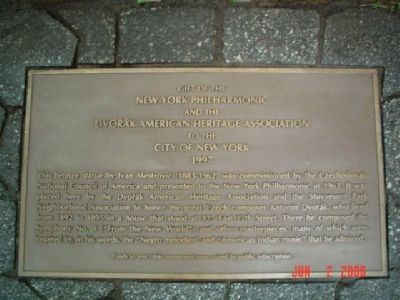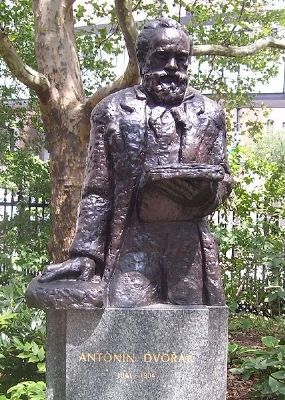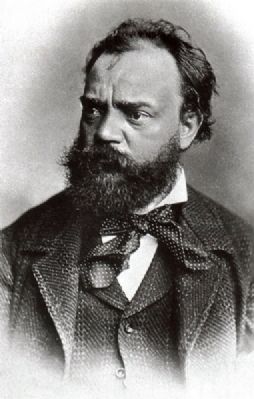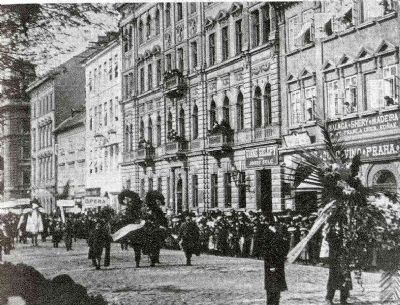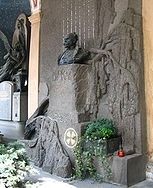Gramercy Park in Manhattan in New York County, New York — The American Northeast (Mid-Atlantic)
Antonin Dvořák plaque and statue
Erected 1997 by The New York Philharmonic and the Dvorak American Heritage Association.
Topics. This historical marker is listed in these topic lists: Arts, Letters, Music • Entertainment. A significant historical year for this entry is 1997.
Location. 40° 44.033′ N, 73° 58.983′ W. Marker is in Manhattan, New York, in New York County. It is in Gramercy Park. Marker can be reached from Stuyvesant Park, Northeast corner. In Stuyvesant Park, Northeast corner. Touch for map. Marker is at or near this postal address: 2nd Avenue and East 15th Street, New York NY 10003, United States of America. Touch for directions.
Other nearby markers. At least 8 other markers are within walking distance of this marker. The Famous Czech Composer (within shouting distance of this marker); Rutherford Place (about 300 feet away, measured in a direct line); Rutherford Medical (about 300 feet away); Pvt. Moses Miller (about 300 feet away); 326, 328, 330 East 18th Street Houses (about 300 feet away); Peter Stuyvesant (about 400 feet away); St. George's Church (about 500 feet away); Stuyvesant Square Historic District (about 600 feet away). Touch for a list and map of all markers in Manhattan.
More about this marker. Figure and plaque: bronze; base: Brazilian green granite (verde lavros)
Regarding Antonin Dvořák plaque and statue. This statue by Croatian-American sculptor Ivan Mestrovic (1883–1962) honors the Czech composer Antonin Dvořák (1841–1904) who made this neighborhood his home for a time, and helped to integrate several musical traditions.
Dvořák was born in the village of Nelahozeves, north of the capital city of Prague, on September 8, 1841. His father kept an inn, and there Dvořák as a child often experienced music-making. He took up the violin, and in 1857 was sent for two years to school in Prague for intensive musical training. At this time Dvořák began composing, and supported himself as a violist, organist, and teacher. He became a violist in the Czech National Theatre Orchestra when it was founded in 1862.
Early on, Dvořák was influenced by the musical compositions of Ludwig van Beethoven (1770–1827) and Franz Schubert (1797–1828), and later by Franz Liszt (1811–1886) and Richard Wagner (1813–1883); he drew equally from Czech and Slavonic folk traditions. In 1873 his cantata Hymnus was publicly performed, and in that year he married Anna Cermakova. An 1875 Austrian state grant brought Dvořák in contact with Johannes Brahms (1833–1897), who provided him with technical advice and found him the influential publisher Fritz Simrock. Over the next 15 years he was a prolific composer, exhibiting a flair for melody, often with a nationalist flavor. His works were performed across Europe, from England to Russia.
In 1892, Dvořák, already internationally renowned, was appointed director of the National Conservatory of Music in America, and settled for three years in New York City at 327 East 17th Street. During his stay in the United States, he was greatly influenced by African-American spirituals and Native American music. His most famous work in this period was the Symphony #9, in E Minor, better known as the New World Symphony (1893). Other notable compositions during his American tenure included the Cello Concerto (1894-95) and the Quartet in F for strings.
Dvořák's impact as a teacher was broad. His students included Harry T. Burleigh, a prominent black baritone; violinist Daniel Visanska whom Dvořák chose to be the concertmaster for the Conservatory orchestra, and young sister and prodigy, pianist Bertha Visanska, who both become renowned performers in Europe; and Amy Beach, the first well-known American woman composer. His pupils included those who would later teach such musical luminaries as Duke Ellington (1899–1974), Aaron Copland (1900–1990), and George Gershwin (1898–1937). In 1895, Dvořák returned to Bohemia, and in 1901 he became director of the Prague Conservatory. In his last years he composed two string quartets, five symphonic poems, and three operas; he died on May 1, 1904.
In the early 1990s Dvořák former house on East 17th Street was designated a city landmark, but rescinded shortly after. Efforts to save the house proved unsuccessful, and it was demolished in 1991. In response, the Dvořák American Heritage Association, in cooperation with the New York Philharmonic and the Stuyvesant Park Neighborhood Association, procured this statue, and raised funds to conserve it, design a new pedestal, install it in the park opposite the site of Dvořák's home, and endow its maintenance.
In 1963, this bronze portrait bust was given by the Czechoslovak National Council of America to the Philharmonic, but never put on public display. It is believed to be the last work of the noted sculptor Mestrovic, a student of Rodin and the first living artist to receive a one-person exhibition at the Metropolitan Museum of Art. Mestrovic’s plaster model for this work is on display in the lobby of the Manhattan School of Music. Consigned to a rooftop terrace of Avery Fisher Hall at Lincoln Center for the Performing Arts, the sculpture was mounted to an inadequate concrete base for three decades, and suffered extensive environmental corrosion.
As part of the relocation project, the statue was repainted, and a new pedestal of green granite was designed by Czech-American architect Jan Hird Pokorny. On September 13, 1997, the effigy of Dvořák was unveiled here near the site of many of his greatest accomplishments. Several hundred spectators and numerous dignitaries, including Jan Koukal, Mayor of Prague, attended the dedication ceremony. It was followed by a Dvořák concert performed by world-class musicians at nearby St. George’s Church.
Sources:
New York City Department of Parks and Recreation
'Dvorak's Ordeal during the American Depression', John Clapham, The Musical Times, 1989.
New York Times, September 30, 1894
Hoopskirts and huppas: chronicle of the early years of the Garfunkel-Trager family in America, 1856-1920. Milton M. Gottesman, American Jewish Historical Society, NY. 1999.
The Evening Post, New York, February 24, 1983, p. 5.
Thirty years of the National Conservatory of Music of America. Henry Theophilus Fink, p. 22, published 1916.
Who's Who in Music and drama: an encyclopedia and biography of notable men in music and drama. Harry Prescott Hanaford. H.A. Hanaford, NY. 1914., p. 309.
Related markers. Click here for a list of markers that are related to this marker. To better understand the relationship, study each marker in the order shown.
Also see . . .
1. 'New World Symphony Number 9', Second Movement. Wiener Philharmonic, Herbert von Karajan, conductor. (Submitted on September 20, 2010, by C.F. Bruce of Columbia, South Carolina.)
2. The Antonin Dvorak Memorial in Vysoka. (Submitted on September 20, 2010, by C.F. Bruce of Columbia, South Carolina.)
3. Antonin Dvorak. Official NYC Parks description. (Submitted on April 7, 2020, by Larry Gertner of New York, New York.)
Credits. This page was last revised on January 31, 2023. It was originally submitted on September 20, 2010, by C.F. Bruce of Columbia, South Carolina. This page has been viewed 1,782 times since then and 54 times this year. Last updated on June 16, 2017, by Larry Gertner of New York, New York. Photos: 1, 2, 3, 4, 5. submitted on September 20, 2010, by C.F. Bruce of Columbia, South Carolina. • Bill Pfingsten was the editor who published this page.
